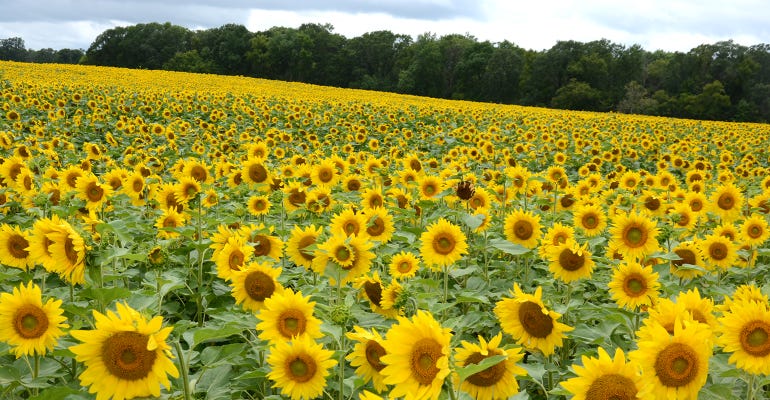
While weather frustrates farmers pushing to finish planting, there is one crop that has a few checkmarks in the positive column.
Sunflowers are holding their own with stable prices, planting time flexibility and available markets.
Kevin Capistran, Crookston, is planting more sunflower acreage this year for a few reasons.
“After last year’s great yields, confidence in growing the crop is high. Sunflower prices are stable while soybean prices look dismal,” he says. “And the rotation allows it.” Last year, Minnesota sunflower production averaged 2,236 pounds per acre, up from 1,817 pounds per acre the year prior.
Sunflowers are very accommodating, he adds.
“Most years, 2019 included, sunflowers get planted last because they can handle later planting,” Capistran says. “If I’m caught up and it’s too cold to plant soybeans, I have no concerns planting sunflowers May 1 into cool soils because they can handle those conditions as well.”
Capistran farms 2,400 acres with his dad, Wayne, raising wheat, barley and soybeans for their seed business. They also raise corn and sugar beets and around 300 to 400 acres of sunflowers. They grow oil-type sunflowers with a large seed size that is used for dehull but can also be used for birdseed or crushed for oil. As of late May, Capistran still had about half of his 2018 sunflower crop in the bin, most, most of which is priced and scheduled for summer delivery.
 POSITIVE OUTLOOK: Kevin Capistran, Crookston, is planting a bit more sunflower acreage this growing season, due to stable prices, available markets and planting flexibility.
POSITIVE OUTLOOK: Kevin Capistran, Crookston, is planting a bit more sunflower acreage this growing season, due to stable prices, available markets and planting flexibility.

Like any crop in storage, they closely monitored the condition of their sunflowers.
“We made sure we took at least a couple loads out of each bin before the weather started warming up to avoid any moisture problems on top,” he adds.
Market outlook
John Sandbakken, National Sunflower Association executive director based in Mandan, N.D., says that sunflower prices have stayed relatively firm the past few months.
“A smaller-than-expected 2018 crop and lower beginning stocks have supported prices,” Sandbakken says. “Demand has been especially strong from the oil crush market this marketing year. [In late May,] prices were pressured by increased producer sales to the plants but are still above historical levels.”
Sunflower products were moving to Canada and Mexico prior to the president’s announcement regarding a 5% tariff on all Mexican products.
“Sunflower products such as oil, meal, confectionary in-shell seed and kernel have a zero tariff in the current NAFTA agreement,” Sandbakken says. “Having a USMCA agreement in place would be great news as it would maintain duty-free status for these products in Canada and Mexico. Canada is the largest export market for U.S. sunflower oil and sunflower kernel. Mexico is the second-largest export market for sunflower oil, confection in-shell seeds and kernel. Passage of this agreement will give sunflower producers certainty in these important markets and allow us to build market share.”
Based on conversations Sandbakken has had with growers and others in the industry, he believes sunflower acres will increase in 2019.
“Sunflower prices are penciling out well in 2019 and the market will continue to be aggressive to get acres this year as stocks will be tight come September, due to smaller 2018 production,” he says.
Sandbakken adds that crushers and confection processors are still offering 2019 production contracts.
 SOLID YIELDS: Last year, Minnesota sunflower production yielded 2,236 pounds per acre. Acreage harvested totaled 51,000 acres.
SOLID YIELDS: Last year, Minnesota sunflower production yielded 2,236 pounds per acre. Acreage harvested totaled 51,000 acres.

“All sunflower demand sectors are offering Act of God contracts for fall delivery,” he says. “These ‘fail-safe’ contracts have become very popular with farmers throughout the production region. They provide an opportunity to lock in attractive prices now for fall delivery and remove that all-important factor of price risk in these very volatile times.”
Another plus for sunflowers? A premium for oil content, which is automatically paid to growers upon delivery to the crush plant.
“Sunflower is the only oilseed that pays premiums for oil content above 40%,” Sandbakken adds. “Oil premiums are offered at the crush plants on oil content above 40% at a rate of 2% price premium for each 1% of oil above 40% oil content. This market year the industry expects to crush about 55% of the crop for oil.”
About the Author(s)
You May Also Like






